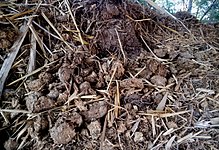Organic Matter
Soil organic matter is the fraction of the soil that consists of plant or animal tissue in various stages of breakdown[1]. Soil organic matter makes up only a small percent of most soils, but it has a great deal of influence on soil properties and agricultural productivity[2]. In the production of a fertile soil, organic substances play a direct part as they are the sources of plant nutrients which are liberated in available forms during mineralization. [3]

Formation Sources
Plant residues and microbial biomass

Microbial biomass (bacteria and fungi) is a measure of the mass of the living component of soil organic matter. The microbial component - microorganisms - decompose plant and animal residues and soil organic matter to release carbon dioxide and nutrients available to plants. Farming strategies that return plant residues (e.g. no-tillage) tend to increase the microbial biomass. Soil properties such as pH, clay, and the availability of organic carbon all influence the size of the microbial biomass. [6]
Detritus

Detritus is living organic matter composed of leaves and other plant parts, animal remains, waste products, and other organic debris that falls onto the soil or into bodies of water from surrounding terrestrial communities. Microorganisms (such as bacteria or fungi) break down detritus, and this microorganism-rich material is eaten by invertebrates, which are in turn eaten by vertebrates. Many freshwater streams have detritus rather than living plants as their energy base[7].
Humus
It has been established that soil organic matter is formed from decomposed plant and animal tissue. Humus is considered to be the stable portion of the soil organic matter; it is the final product of decomposition, forming in a process referred to as "humification." It generally exists as a complex aggregate of brown to dark colored amorphous substances, which have originated during decomposition, under aerobic and anaerobic conditions; this usually occurs in soils, composts, peat bogs, and water basins. Different humus types can be represented in an advanced state of decomposition, produced from various plant residues at different periods during prehistoric times, and later stratified and compressed by superimposed layers of mineral matter[8].
Importance of Organic Matter
Physical Benefits
- Improves soil structure, which further helps to control soil erosion, improves water infiltration and water holding capacity.
- Reduces surface crusting, facilitating seedbed preparation.
- Provides better living conditions to plant roots and soil organisms.
Chemical Benefits
- Improves the capacity of a soil to store and supply essential nutrients (e.g. nitrogen, phosphorus, potassium, calcium and magnesium).
- Improves the ability of a soil to resist pH change (buffering capacity).
- Improves the capacity of a soil to retain toxic elements.
- Allows the soil to cope with changes in soil acidity.
- Helps accerelate soil minerals to decomposition, making the nutrients in the minerals available for plant uptake.
Biological Benefits
- Supports soil functionality as a primary source of carbon which gives energy and nutrients to soil organisms.
- Improves the activity of microorganisms in the soil and enhances biodiversity, which can help in the suppression of diseases and pests.
- Drcrease the emssions of CO2 to the atmostphere by capturing carbon in the soil, and hence mitigates climate change. [9]
Organic Matter Management
Proper farm practices can help to maintain or increase soil organic matter levels.
- Use of conservation tillage practices (e.g. zone tillage or no-till); tillage exposes the organic matter and results in the decrease of the amount of stable organic matter due to increased mineralization rates and erosion losses.
- Rotation of annual row crops with perennial grass or legume sods: this reduces erosion and builds up organic matter as a result of the decomposition of the root mass.
- Establish legume cover crops: this enhances organic matter accumulation by providing the nitrogen needed for decomposition of freshly added organic materials, especially those with a high C to N ratio (e.g. corn stover, cereal, straw, heavily bedded manure).
- Avoid soil compaction: this increases water-logging.
- Maintain proper pH: this enhances microbial activity and decomposition of freshly added materials. [10]
References
- ↑ Department of Crop and Soil Sciences,Soil Organic Matter, Agronomy Fact Sheet Series - Fact Sheet 41, Cornell University Cooporative Exentensive.
- ↑ Grubinger, V. Soil Organic Matter: The Living, the Dead, and the Very Dead https://www.uvm.edu/vtvegandberry/factsheets/soilorganicmatter.html.
- ↑ Senn, T. L. and Alta R. Kingman, 1973, A review of Humus and Humic Acids. Research Series No. 145, S. C. Agricultural Experiment Station, Clemson, South Carolina.
- ↑ USGS, What is organic matter?, https://www.usgs.gov/labs/organic-matter-research-laboratory/what-organic-matter-0.
- ↑ Soil Quality Fact Sheet. https://soilquality.org.au/factsheets/microbial-biomass#:~:text=Microbial%20biomass%20(bacteria%20and%20fungi,dioxide%20and%20plant%20available%20nutrients.
- ↑ Soil Quality Fact Sheet. https://soilquality.org.au/factsheets/microbial-biomass#:~:text=Microbial%20biomass%20(bacteria%20and%20fungi,dioxide%20and%20plant%20available%20nutrients.
- ↑ Britannica. https://www.britannica.com/science/detritus
- ↑ Senn, T. L. and Alta R. Kingman, 1973, A review of Humus and Humic Acids. Research Series No. 145, S. C. Agricultural Experiment Station, Clemson, South Carolina.
- ↑ European Commission, 2016, Soil Organic Matter Matters: Investing in Soil Quality for Long-term Benefits.
- ↑ Department of Crop and Soil Sciences, Soil Organic Matter, Agronomy Fact Sheet Series, Fact Sheet 41.